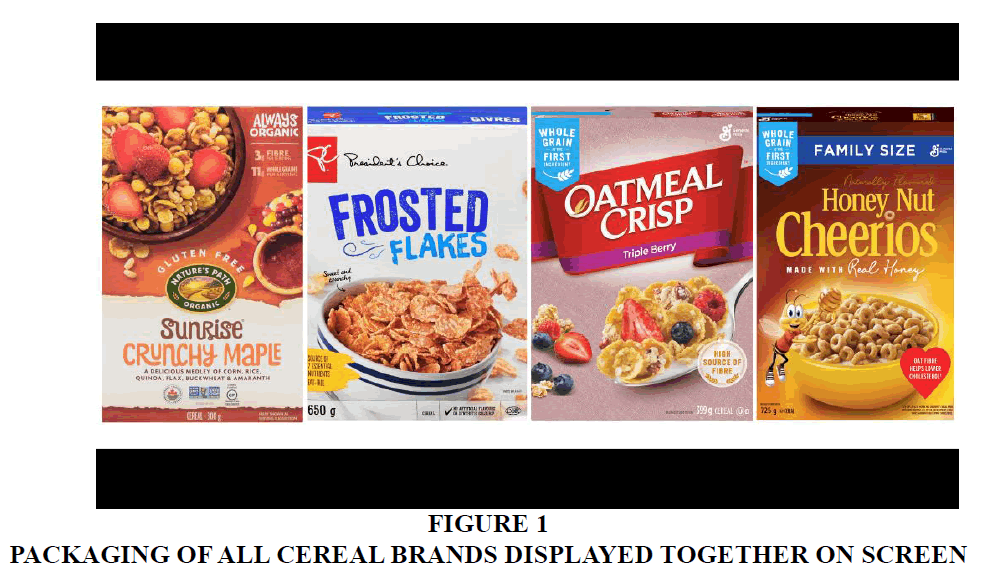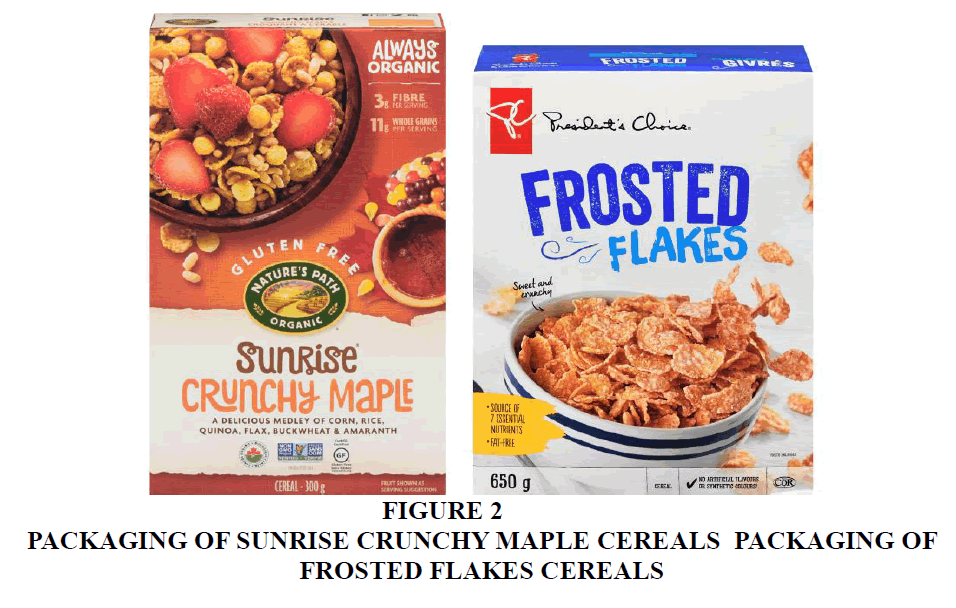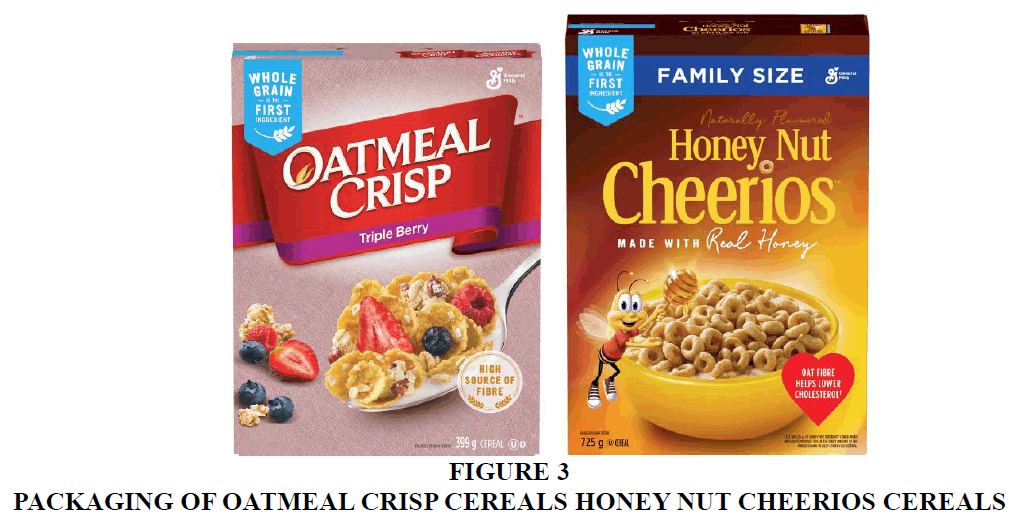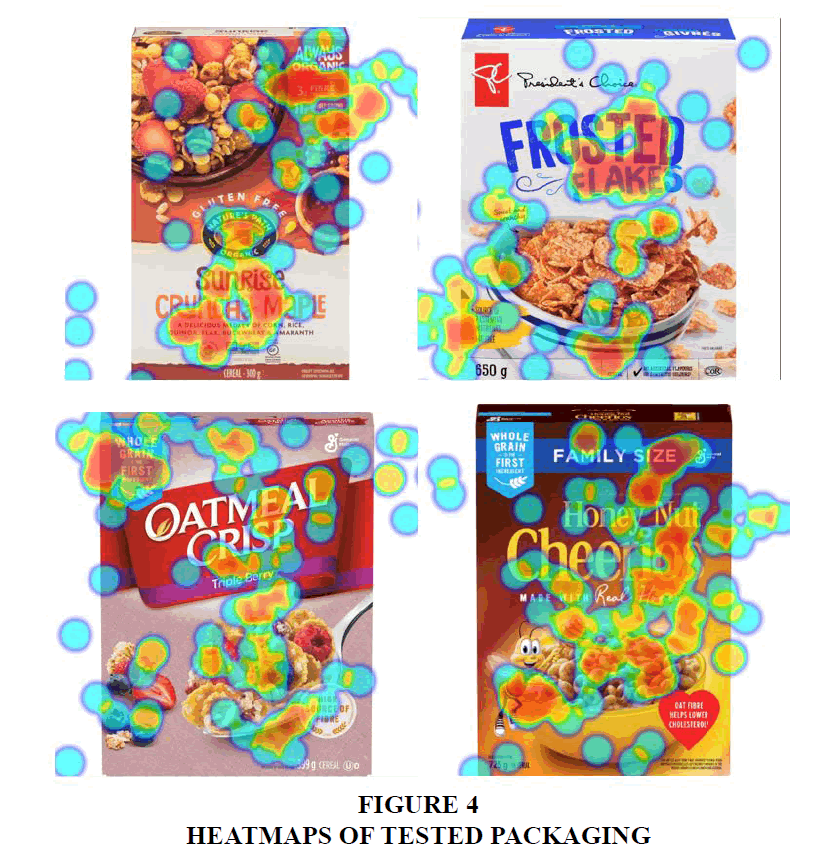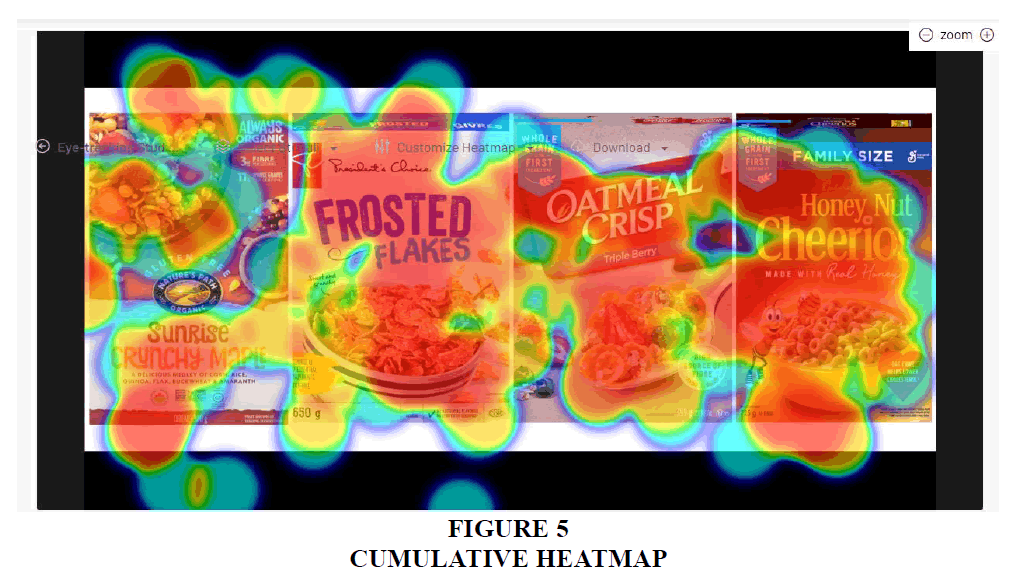Research Article: 2024 Vol: 28 Issue: 5S
Eye Tracking in Neuromarketing: A Study on Visual Attention Patterns
Yashodhan Karulkar, SVKM's Narsee Monjee Institute of Management Studies (NMIMS) Deemed-to-be-University
Christine D’Lima, SVKM's Narsee Monjee Institute of Management Studies (NMIMS) Deemed-to-be-University
Avantika Sharma, SVKM's Narsee Monjee Institute of Management Studies (NMIMS) Deemed-to-be-University
Mihir Gada, SVKM's Narsee Monjee Institute of Management Studies (NMIMS) Deemed-to-be-University
Anjor Tank, SVKM's Narsee Monjee Institute of Management Studies (NMIMS) Deemed-to-be-University
Citation Information: Karulkar, Y., D’Lima, C., Sharma, A., Gada, M., & Tank, A. (2024). Eye tracking in neuromarketing: a study on visual attention patterns. Academy of Marketing Studies Journal, 28(S5), 1-11.
Abstract
Packaging is a powerful tool for brands, which can not only catch consumers’ attention but also influence their purchase decisions. The application of neuromarketing techniques to the study of food packaging has recently gained considerable popularity both in academia and practice. This represents the motivation of this investigation, whose objective is to investigate the use of eye tracking in neuromarketing and how it improves the effectiveness of advertising and consumer engagement. The data was collected using Realeye.io software on four cereal brands unknown to the Indian market to avoid the familiarization bias. The result highlighted the importance of visual attention patterns and packaging design to influence participants' purchase intentions.
Keywords
Neuromarketing, Eye Tracking, Consumer Neuroscience, Visual Attention.
Introduction
Neuromarketing is a marketing field that uses insights and techniques from neuroscience to understand and influence consumer behavior. It is based on the idea that much of our decision-making and behavior is driven by unconscious processes, and that by studying these processes, marketers can gain a deeper understanding of what motivates consumers to buy, and how to appeal to them more effectively.
Neuromarketing uses a variety of methods, including brain imaging (such as functional magnetic resonance imaging or fMRI), biometrics (such as skin conductance and heart rate), and eye tracking, to measure and analyze how consumers respond to marketing stimuli, such as advertisements, products, and packaging. By studying consumers' neural and physiological responses, neuromarketers can identify what aspects of a product or message are most appealing or engaging and optimize marketing strategies accordingly.
Eye tracking is a method of neuromarketing that enables the measurement and analysis of eye movements and gaze patterns to study how consumers interact with various forms of advertising, such as print ads, websites, and packaging. By analyzing eye movements, researchers can identify which parts of an ad or package are most visually salient, which elements are most likely to capture and hold the viewer's attention, and which elements are most likely to be remembered.
The application of neuromarketing techniques to packaging has recently gained considerable popularity both in academia and practice. Evidence of this can be seen in companies such as Nielsen, Kantar or Ipsos, which have included neuromarketing in their commercial offers.
In a sum, neuromarketing uses a range of methods to study the brain and behavior of consumers in response to marketing stimuli. By combining multiple methods, neuromarketers can better understand how consumers respond to marketing stimuli and optimize their marketing strategies accordingly.
Review of Literature
The term neuromarketing was first used in 2002 by German professor Ale Smidts who defined neuromarketing as “the study of the cerebral mechanism to understand the consumer’s behavior in order to improve the marketing strategies”. (Cosic, 2016; Orzan, et al., 2012).
According to, for the past two decades, marketing researchers tended to neglect the emotional part of consumer behavior while much focusing on decision-oriented models of information processing, while all marketers hope to understand customers and their purchase decisions. However, when explicitly asked, most people cannot fully and sometimes, do not even want to explain their choices. Somehow, they are not aware of the inner processes that drive their reactions and decisions. This is because 95% of the decision-making process occurred subconsciously (H. Zamani; G. Calvert, 2012); (Ramsøy) examined how neuromarketing uses a variety of brain scan techniques (such as FMRI, PET and EEG), eye tracking, and physiological measurements (heart rate, breathing rate and galvanic skin response) to understand the unconscious drivers of choice and preference. Because consumers are not aware of these drivers, they cannot be detected by traditional techniques such as focus groups, interviews, and questionnaires. One can think that this brings the end to the traditional methods in market research, but it is more appropriate to view them as “upgraded” with methods such as eye tracking (Ramsøy; Cosic, 2016).
In all neuromarketing studies, participants are exposed to some sort of stimulus in form of different ads/commercials, still pictures, texts etc. and their response is observed/measured by one or more of the following techniques (Cosic, 2016). Kalkova1 (2020) argued that capturing the consumer’s visual attention should be regarded as a primary objective in marketing communications, given the information overload in today’s marketplace. “The eyes are the windows to our soul”. This well-known proverb about the sense of vision might be the spark to the emergence of eye tracking technology (H. Zamani). (Rundh, 2005) examined that while touring supermarket shelves, each consumer may pass up to 300 different products per minute. This means that brands’ opportunities to catch consumers’ attention are very limited. Competing in such an overstimulated context entails a huge challenge for brands, and to face it, packaging appears to be a good weapon (Ingrit Moya, 2020).
The importance of packaging in marketing strategies has been extensively studied since packaging not only is the container to hold, protect, preserve and facilitate the handling and commercialization of products (Hassan, et al., 2012), but it also communicates brand identity, attracts consumers’ attention and helps to position the product within a concrete category (Gómez, et al., 2015). Moreover, argues that packaging is especially important in generating added value for products and influencing consumers’ shopping behavior. (Ingrit Moya, 2020; Méndez, et al., 2011; Clement, 2007; Silayoi, et al., 2004). (Qian Li, 2015) conducted a study to analyze and assess the visual and neurocognitive perception of consumers of mandatory labelling information on the package of dairy products in order to find the area of its best location, which will allow the consumer to assess the quality of sold products quickly. In the work, they describe that the visual elements of colour on the milk package, as well as the placed information factors (label) affect the consumers’ behavior significantly.
(Cuesta, 2018) examined that when consumers need to acquire information about choice, they need to direct their attention toward the plethora of flashy packages and pay attention to the stimulus features that are relevant for their choice.
The main purpose of our eye movements is to accumulate sensory evidence to efficiently carry out actions. One way we do this is by using fixations to lower the demands on working memory. When standing in front of a supermarket shelf, we do not learn and remember all the information about all the products, but instead, carry out fixations to make multiple comparisons, and mentally organize suitable options into consideration sets. Due to carrying out more fixations, working memory demands decrease, and attention increases using fixations as external memory space (Cuesta, 2018).
Through eye tracking, it is possible to visually document a consumer’s journey during the whole study. Within the context of visual choice and comparison tasks, monitoring the distribution and duration of eye fixations may provide an excellent measure of an observer’s interests and preferences (Glaholt, 2009).
Moreover, it is also documented that visual attention toward brand-related elements (e.g. labels) corresponds to a general attitude toward the brand (Graham, 2012). According to (Venkatraman, 2015), ET, used as a direct measure of attention, is probably the most accessible method for catching ad response, which enables capturing not only which information was processed, but also the order and duration of these processes. (Oliveira, 2019) come to similar conclusions by demonstrating that visual attention captured with ET is different for weak and strong brands.
Analysis of Packaging
According to one of the most common design approaches, a key role of design is organizing visual communication (Byrne, 1990; Yang & Hsu, 2015).
As Frascara (1988, p. 21) puts it, design should not be understood in isolation but only within a communication system. Thus, a packaging designer should not only look for a result that guarantees that all functional requirements are met but also that has the desired effect on consumer perception and that communicates in an efficient way (Hembree, 2008; Munari, 1973; Munari,2016).
(Ares et al., 2011; Smith, Barratt et al., 2015; Thomson, 2016) argued that consumers infer meaning from each packaging cue (e.g. colors, images, or packaging shape) so each cue should be designed with consideration to what will be its role in the communication process.
Food packaging has two particularities that reinforce its relevance as a marketing tool. On the one hand, the packaging is always present at the point of sale (even in an online environment, where an image of the packaged product is usually shown), so packaging always mediates the relationship between the product and the consumer at the time of purchase. This is especially important in light of some studies that show that unplanned shopping and in-store decision-making have increased in recent years (Gilbride et al., 2015). On the other hand, it is worth noting that on many occasions, the packaging is also present at the time of product consumption. Products such as drinks, jams, preserves, or snacks are consumed directly from the packaging or with the packaging in sight, and some estimates indicate that the number of products that are consumed directly from their package amounts to one-third of the total (Spence, 2017). This implies that packaging cues such as colour, weight, or even the way the package sounds can exert influence on consumer perception, not only at the buying stage (i.e. when expectations are set) but also on the overall consumption experience (Krishna et al., 2017; Spence, 2016).
Methodology
In our neuromarketing research study, we aimed to understand how customers would look at product packaging in a cluttered market space. To achieve this, we selected cereals as the product and looked specifically at their packaging. We chose four cereal brands that were unknown to Indian customers, to ensure that respondents would have no prior biases or preconceptions. We utilized Realeye.io software to track the eye movements of respondents while flashing images of the cereals on a laptop screen.
Analysis was done using heat maps, gaze points, and areas of interest extracted from the software. To evaluate participants’ attitude towards the tested packaging, a questionnaire was also applied.
Following was our approach
1. Determined the sample size: We used a sample size of 20–23-year-old college students.
2. Selected the cereals to use in the study: We chose four cereal brands from the Canadian market that were possibly unknown to Indian customers.
3. Used eye-tracking software to observe eye movements: We used Realeye.io software to track the eye movements of the respondents when flashing images of the cereals on a laptop screen.
4. Determined the sequence and duration of the images: First, we flashed all four brands (Figure 1) on the screen together for 12 seconds to observe eye movement patterns.
Second, we flashed four images one by one Figures 1-5 each showing one packaged product for 6 seconds to determine what particular aspects the respondents were looking for in one single packaging.
Figure 1 Packaging of all Cereal Brands Displayed Together on Screen
Lastly, we flashed an image of all four products arranged from left to right, similar to the first image as shown in Figure 1, for 10 seconds to reaffirm which packaging the respondents focused on more when they had seen all four product packaging.
5. Extracted data using eye-tracking software: We used the heat maps, gaze points, and areas of interest extracted from the eye-tracking software to analyze the study further.
6. Assessed dependent variables using a Likert scale: To assess participants' attitudes towards the tested packaging, a questionnaire was used with three dependent variables: (1) appreciation, (2) perceived complexity, and (3) purchase intention.
Appreciation was measured using two semantic differential items: not appealing/very appealing and dislike/like. The response options were on a seven-point Likert scale. Perceived complexity was measured using two semantic differential items: straightforward-unclear and easy-to-understand-difficult-to-understand, also on a seven-point Likert scale. To assess purchase intention, two questions were asked with answer options ranging from 1 (strongly disagree) to 7 (strongly agree). The questions, "I would consider buying this product" and "I would recommend this product," were assessed using a Google form that was filled out by the respondents to gather these responses.Top of Form
Data Analysis
The eye movement data in this research was analysed using heatmaps generated from the eye tracking data obtained through the RealEye tool. Heatmaps provided visual representations of gaze patterns, with warmer colours indicating higher attention and cooler colours indicating lower attention. These heatmaps offered valuable insights into consumer attention towards the food packaging design.
The heatmaps revealed that the front of the packaging, including the product image and logo, received the highest attention from consumers, as indicated by the warmer colours on the heatmap. This suggests that consumers focused on these areas of the food packaging design. In contrast, the sides and bottom of the packaging received lower attention, as evident from the cooler colours on the heatmap.
The below figures present the heatmap for the products shown.
The average fixation duration on the product image and logo on the front of the packaging was 2.14 seconds, while the fixation duration on the nutritional information and attributes of the packaging was 0.69 seconds. Additionally, the fixation count on the product image and logo was 21, while the fixation count on the nutritional information was 12.
These results suggest that the front of the food packaging design, including the product image and logo, received the highest attention from consumers, indicating their importance in capturing consumer attention and potentially influencing purchase decisions. On the other hand, the nutritional information and product attributes mentioned on the packaging received moderate attention from consumers, suggesting their potential role as less influential in consumer perception.
Furthermore, the findings from the heatmap analysis can be used to optimize the food packaging design by prioritizing and enhancing the areas that attract the most attention from consumers, such as the product image and logo on the front of the packaging. This information can be valuable for marketing and packaging design strategies to create packaging that effectively captures consumer attention and influences their purchase decisions.
In addition to the eye tracking data, post-experiment interviews were conducted to gather qualitative insights on participants' preferences and purchase intentions based on their visual attention patterns. The interviews revealed several interesting findings.
Results
Participants expressed a strong preference for products that received the highest number of fixations during the eye tracking task. They indicated that their attention was drawn to packaging designs with prominent product images and logos, as well as clear and visually appealing product attributes.
Overall, the post-experiment interviews highlighted the importance of visual attention patterns, packaging design, and emotional appeal in influencing participants' purchase intentions. The findings suggest that the number of fixations on a product, along with other visual elements such as packaging design and emotional appeal, can significantly impact a person's likelihood to purchase a product.
Discussion
Every consumer is affected by brands, social connections, context, price etc., either on a conscious or a subconscious level. Neuromarketing research provides objective insights into consumer behavior, which can be difficult to obtain through traditional market research methods, such as surveys and focus groups. It’s techniques can reveal unconscious and emotional responses of consumers, which can provide a deeper understanding of consumer behavior and decision-making. The insights we gained from neuromarketing research can be used to develop more effective marketing strategies, which can lead to increased sales and revenue.
However, there are ethical concerns associated with the use of neuromarketing techniques, such as invasion of privacy and manipulation of consumer behavior and the research is often expensive and time-consuming, which may not be feasible for all companies.
Limitations
With reference to limitations, a common criticism against the use of neuroscience methods to study consumer behavior is the use of relatively small sample sizes, perceived as resulting in low statistical power. However, previous research has shown that consumer neuroscience studies are capable of producing meaningful insights and predictive results using small sample sizes.
On the other hand, as stated by Mast and Zaltman, a great deal of experimental work is required to identify which set of problems are best addressed using neuromarketing and how the information provided by its techniques could be better complement existing methods. In this sense, the present study is a starting point for further research that will demonstrate what kind of issues related to packaging could be better addressed through the use of neuromarketing.
Therefor, this study faced the following limitations –
Limited sample size: The research used a small sample size from within the university in Mumbai, which may not be representative of the larger population. This can limit the generalizability of the findings and make it difficult to draw conclusions about the broader population.
Limited scope: The research have only examined a specific aspect of neuromarketing, such as the effect of visual stimuli on consumer behavior. This can limit the applicability of the findings to other aspects of neuromarketing
Methodological limitations: The study may have had methodological limitations that could impact the validity of the results. For example, the tool used, Realeye.io to track eye movements and other physiological responses may have been limited in their accuracy or reliability.
Practical Implications
The study on neuromarketing using eye tracking software to track eye movements on customers can have several practical implications for marketers in the cereal industry. Here are some of them:
Packaging Design: The study can help marketers in designing the packaging of cereals that will catch the attention of customers in a cluttered market. They can use the insights from eye-tracking data to create packaging that draws the eye to important features, such as the brand name, serving pictures, and other relevant information.
Branding: The study can also help marketers understand how customers perceive their brand, based on their eye movements. They can use this information to improve their branding strategy, by making changes to the packaging, brand name, and other elements to make their brand more attractive to customers.
Product Placement: By understanding where customers focus their attention on the packaging, marketers can determine the best placement for various product features, such as the brand name, serving pictures, and other relevant information.
Targeted Marketing: The study can also help marketers target specific customer segments with their marketing messages. They can use the eye-tracking data to determine which aspects of the packaging appeal most to different customer groups, and adjust their marketing accordingly.
When it comes to the representation of images, brand name, and serving pictures on cereal packaging, here are some points to consider:
Images: Eye-tracking studies have shown that customers tend to focus on images that convey emotion, such as happy families or smiling faces. Using such images on cereal packaging can help to create an emotional connection with customers and make the product more appealing.
Brand Name: The brand name should be prominently displayed on the packaging and be easy to read. Eye-tracking studies have shown that customers tend to focus on the top left corner of the packaging, so this is a good location for the brand name.
Serving Pictures: Eye-tracking studies have also shown that customers tend to focus on serving pictures that show the product in use. For example, a picture of cereal in a bowl with milk and fruit can be more effective than a picture of just the cereal. Additionally, the serving size should be clearly indicated, as this can affect the perceived value of the product.
In a cluttered market space, it's important to create packaging that stands out and draws the customer's attention. By using eye-tracking technology, marketers can gain valuable insights into how customers perceive their product and make changes to improve its appeal.
Future Scope
Eye tracking is already widely used in neuromarketing, but there are several areas in which the technique could be further developed and applied. Here are some potential future applications and areas of research for eye tracking in neuromarketing:
1. Virtual and augmented reality: As virtual and augmented reality technologies become more prevalent, eye tracking could be used to measure user engagement and attention in these environments. This could help developers create more immersive and engaging experiences for consumers.
2. Mobile devices: Eye tracking could be integrated into mobile devices, such as smartphones and tablets, to provide real-time feedback on user attention and engagement with ads and other marketing content.
3. Multimodal integration: Eye tracking could be combined with other neuromarketing techniques, such as EEG and biometric measurements, to provide a more comprehensive understanding of consumer behavior and decision-making.
4. Personalization: Eye tracking could be used to measure individual differences in attention and engagement with marketing stimuli. This could help marketers create more personalized advertising and product designs that are tailored to individual consumers.
5. Cross-cultural studies: Eye tracking could be used to compare and contrast consumer behavior and decision-making across different cultures and demographic groups. This could provide valuable insights for global marketing campaigns and product designs.
Overall, eye tracking is a versatile and powerful tool in neuromarketing, and has the potential to be further developed and applied in a range of contexts.
Conclusion
Although the use of neuroscience insights and methods has been shown to improve our understanding of consumer behavior, the use of a multi-method approach is highly recommendable to strengthen the results of using neuroscience methods.
The present study provides evidence of how, through the integration of declarative and neuromarketing techniques, we gain a more holistic approach to the consumer reactions to food packaging evaluation.
Undoubtedly, the application of neuroscience techniques in food packaging research represents a huge step, but in order to provide relevant answers for brands, further research is needed to understand how the different elements of packaging influence the product evaluation and consequently the purchase decision.
In addition, despite the large number of scholars studying food packaging by using neuromarketing tools, this is a young discipline. Consequently, its theoretical, empirical and practical field is still in development. Therefore, from the academic side, we must provide a validation framework that helps neuromarketing companies to provide metrics capable of responding to what they are supposed to measure. Only through joint efforts to achieve standardization in this discipline will we eradicate the overpromising and under-delivering that have been affecting the reputation of our area.
References
Calvert, G. A., & Brammer, M. J. (2012). Predicting consumer behavior: using novel mind-reading approaches. IEEE pulse, 3(3), 38-41.
Indexed at, Google Scholar, Cross Ref
Clement, J. (2007). Visual influence on in-store buying decisions: an eye-track experiment on the visual influence of packaging design. Journal of marketing management, 23(9-10), 917-928.
Indexed at, Google Scholar, Cross Ref
Ćosić, D. (2016). Neuromarketing in market research. Interdisciplinary Description of Complex Systems: INDECS, 14(2), 139-147.
Indexed at, Google Scholar, Cross Ref
Cuesta, U., Niño, J. I., & Martínez-Martínez, L. (2018). Neuromarketing: analysis of packaging using Gsr, eye-tracking and facial expression. In Papper presented at The European Conference on Media, Communication & Film.
Frascara, J. (1988). Graphic design: Fine art or social science?. Design issues, 5(1), 18-29.
Gilbride, T. J., Inman, J. J., & Stilley, K. M. (2015). The Role of Within-Trip Dynamics in Unplanned Versus Planned Purchase Behavior. Journal of Marketing, 79(3), 57–73.
Indexed at, Google Scholar, Cross Ref
Glaholt, M. G., Wu, M. C., & Reingold, E. M. (2009). Predicting preference from fixations. PsychNology J., 7(2), 141-158.
Gómez, M., Martín‐Consuegra, D., & Molina, A. (2015). The importance of packaging in purchase and usage behaviour. International journal of Consumer studies, 39(3), 203-211.
Indexed at, Google Scholar, Cross Ref
Graham, D. J., & Jeffery, R. W. (2012). Predictors of nutrition label viewing during food purchase decision making: An eye tracking investigation. Public health nutrition, 15(2), 189-197.
Indexed at, Google Scholar, Cross Ref
Hassan, S. H., Leng, L. W., & Peng, W. W. (2012). The influence of food product packaging attributes in purchase decision: A study among consumers in Penang, Malaysia. Journal of Agribusiness Marketing, Vol. 5, December 2012, p. 14-28.
Hembree, R. (2006). The complete graphic designer: a guide to understanding graphics and visual communication. Rockport publishers.
Krishna, A., Cian, L., & Aydınoğlu, N. Z. (2017). Sensory aspects of package design. Journal of Retailing, 93(1), 43-54.
Indexed at, Google Scholar, Cross Ref
Li, Q., Huang, Z. J., & Christianson, K. (2016). Visual attention toward tourism photographs with text: An eye-tracking study. Tourism Management, 54, 243-258.
Indexed at, Google Scholar, Cross Ref
Luis Mendez, J., Oubina, J., & Rubio, N. (2011). The relative importance of brand‐packaging, price and taste in affecting brand preferences. British Food Journal, 113(10), 1229-1251.
Moya, I., García-Madariaga, J., & Blasco, M. F. (2020). What can neuromarketing tell us about food packaging?. Foods, 9(12), 1856.
Indexed at, Google Scholar, Cross Ref
Munari, B., & Cantarell, FSI (2016). Design and visual communication. Gustavo Gili Editorial.
Oliveira, J. H. C. D., & Giraldi, J. D. M. E. (2019). Neuromarketing and its implications for operations management: an experiment with two brands of beer. Gestão & Produção, 26, e3512.
Indexed at, Google Scholar, Cross Ref
Orzan, G., Zara, I. A., & Purcarea, V. L. (2012). Neuromarketing techniques in pharmaceutical drugs advertising. A discussion and agenda for future research. Journal of medicine and life, 5(4), 428.
Ramsøy, T. Z. (2014). An Introduction to Consumer Neuroscience & Neuromarketing [Video]. Coursera,(2014, November 10–2015, January 6).
Rundh, B. (2005). The multi‐faceted dimension of packaging: Marketing logistic or marketing tool?. British food journal, 107(9), 670-684.
Silayoi, P., & Speece, M. (2004). Packaging and purchase decisions: An exploratory study on the impact of involvement level and time pressure. British food journal, 106(8), 607-628.
Smith, V., Barratt, D., & Selsøe Sørensen, H. (2015). Do natural pictures mean natural tastes? Assessing visual semantics experimentally. Cognitive Semiotics, 8(1), 53-86.
Venkatraman, V., Dimoka, A., Pavlou, P. A., Vo, K., Hampton, W., Bollinger, B., & Winer, R. S. (2015). Predicting advertising success beyond traditional measures: New insights from neurophysiological methods and market response modeling. Journal of Marketing Research, 52(4), 436-452.
Indexed at, Google Scholar, Cross Ref
Zamani, H., Abas, A., & Amin, M. K. M. (2016). Eye tracking application on emotion analysis for marketing strategy. Journal of Telecommunication, Electronic and Computer Engineering (JTEC), 8(11), 87-91.
Received: 15-Feb-2024, Manuscript No. AMSJ-24-14507; Editor assigned: 16-Feb-2024, PreQC No. AMSJ-24-14507(PQ); Reviewed: 29-Apr-2024, QC No. AMSJ-24-14507; Revised: 15-May-2024, Manuscript No. AMSJ-24-14507(R); Published: 15-Jun-2024
